brake JEEP WRANGLER 2015 JK / 3.G Owner's Manual
[x] Cancel search | Manufacturer: JEEP, Model Year: 2015, Model line: WRANGLER, Model: JEEP WRANGLER 2015 JK / 3.GPages: 156, PDF Size: 23.54 MB
Page 118 of 156
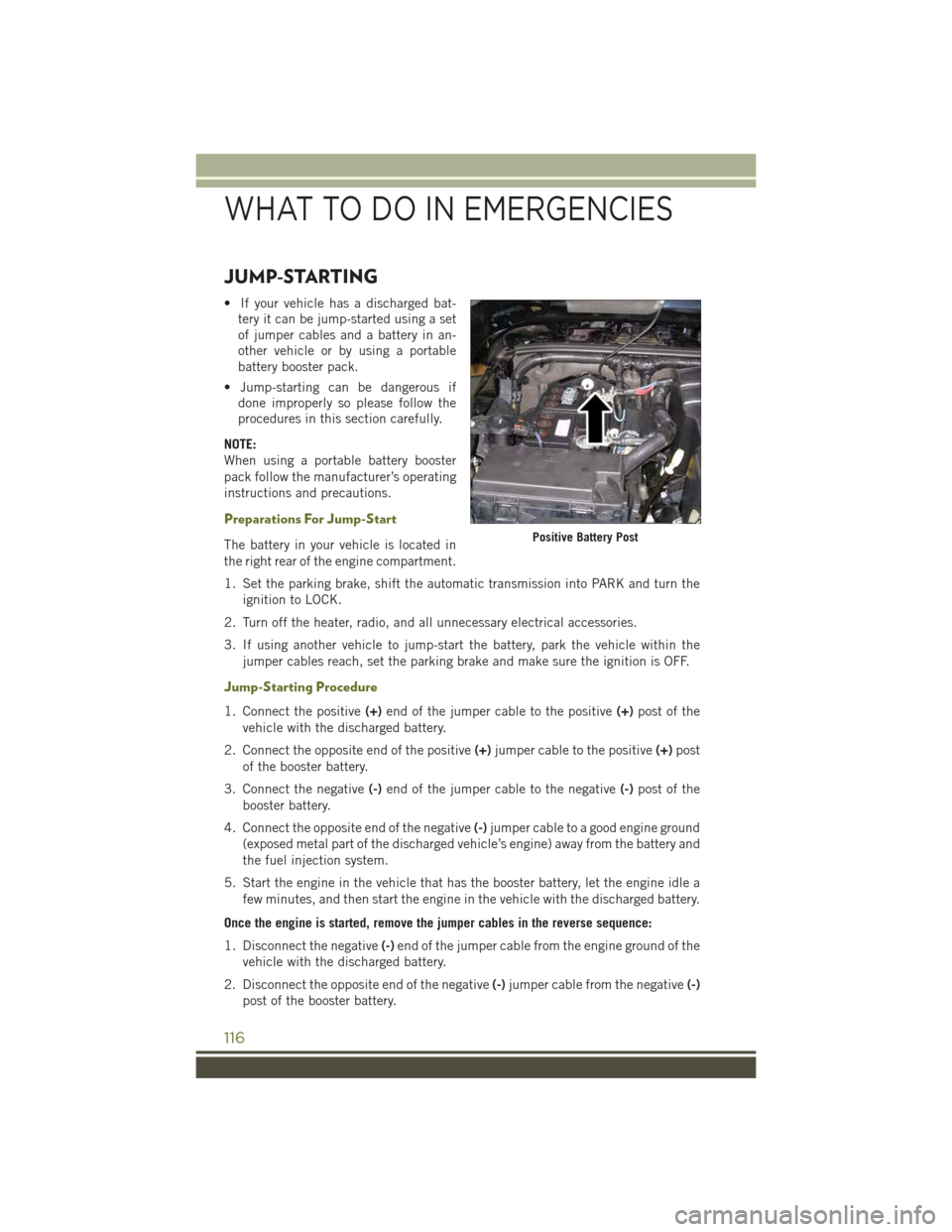
JUMP-STARTING
• If your vehicle has a discharged bat-
tery it can be jump-started using a set
of jumper cables and a battery in an-
other vehicle or by using a portable
battery booster pack.
• Jump-starting can be dangerous if
done improperly so please follow the
procedures in this section carefully.
NOTE:
When using a portable battery booster
pack follow the manufacturer’s operating
instructions and precautions.
Preparations For Jump-Start
The battery in your vehicle is located in
the right rear of the engine compartment.
1. Set the parking brake, shift the automatic transmission into PARK and turn the
ignition to LOCK.
2. Turn off the heater, radio, and all unnecessary electrical accessories.
3. If using another vehicle to jump-start the battery, park the vehicle within the
jumper cables reach, set the parking brake and make sure the ignition is OFF.
Jump-Starting Procedure
1. Connect the positive(+)end of the jumper cable to the positive(+)post of the
vehicle with the discharged battery.
2. Connect the opposite end of the positive(+)jumper cable to the positive(+)post
of the booster battery.
3. Connect the negative(-)end of the jumper cable to the negative(-)post of the
booster battery.
4. Connect the opposite end of the negative(-)jumper cable to a good engine ground
(exposed metal part of the discharged vehicle’s engine) away from the battery and
the fuel injection system.
5. Start the engine in the vehicle that has the booster battery, let the engine idle a
few minutes, and then start the engine in the vehicle with the discharged battery.
Once the engine is started, remove the jumper cables in the reverse sequence:
1. Disconnect the negative(-)end of the jumper cable from the engine ground of the
vehicle with the discharged battery.
2. Disconnect the opposite end of the negative(-)jumper cable from the negative(-)
post of the booster battery.
Positive Battery Post
WHAT TO DO IN EMERGENCIES
116
Page 120 of 156
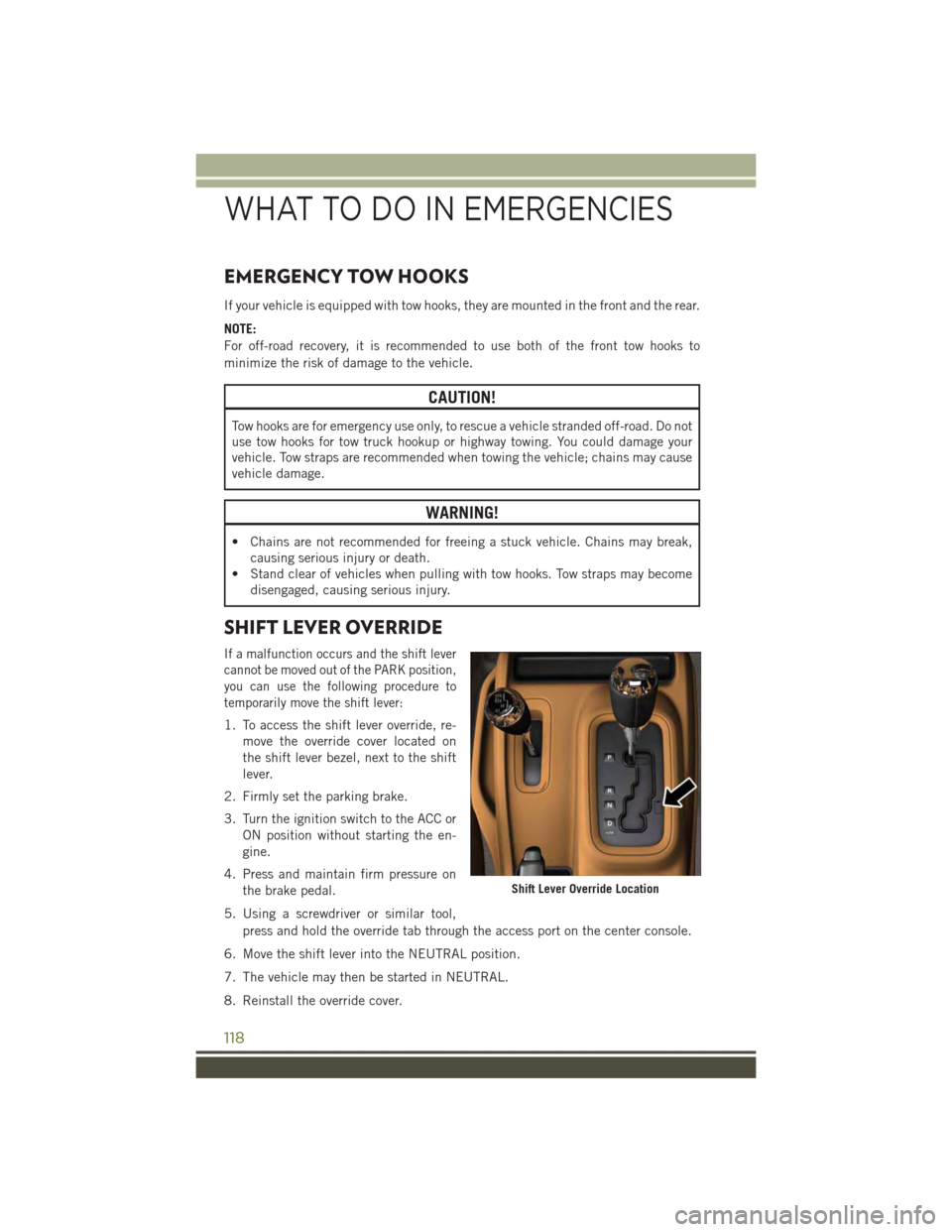
EMERGENCY TOW HOOKS
If your vehicle is equipped with tow hooks, they are mounted in the front and the rear.
NOTE:
For off-road recovery, it is recommended to use both of the front tow hooks to
minimize the risk of damage to the vehicle.
CAUTION!
Tow hooks are for emergency use only, to rescue a vehicle stranded off-road. Do not
use tow hooks for tow truck hookup or highway towing. You could damage your
vehicle. Tow straps are recommended when towing the vehicle; chains may cause
vehicle damage.
WARNING!
• Chains are not recommended for freeing a stuck vehicle. Chains may break,
causing serious injury or death.
• Stand clear of vehicles when pulling with tow hooks. Tow straps may become
disengaged, causing serious injury.
SHIFT LEVER OVERRIDE
If a malfunction occurs and the shift lever
cannot be moved out of the PARK position,
you can use the following procedure to
temporarily move the shift lever:
1. To access the shift lever override, re-
move the override cover located on
the shift lever bezel, next to the shift
lever.
2. Firmly set the parking brake.
3. Turn the ignition switch to the ACC or
ON position without starting the en-
gine.
4. Press and maintain firm pressure on
the brake pedal.
5. Using a screwdriver or similar tool,
press and hold the override tab through the access port on the center console.
6. Move the shift lever into the NEUTRAL position.
7. The vehicle may then be started in NEUTRAL.
8. Reinstall the override cover.
Shift Lever Override Location
WHAT TO DO IN EMERGENCIES
118
Page 122 of 156
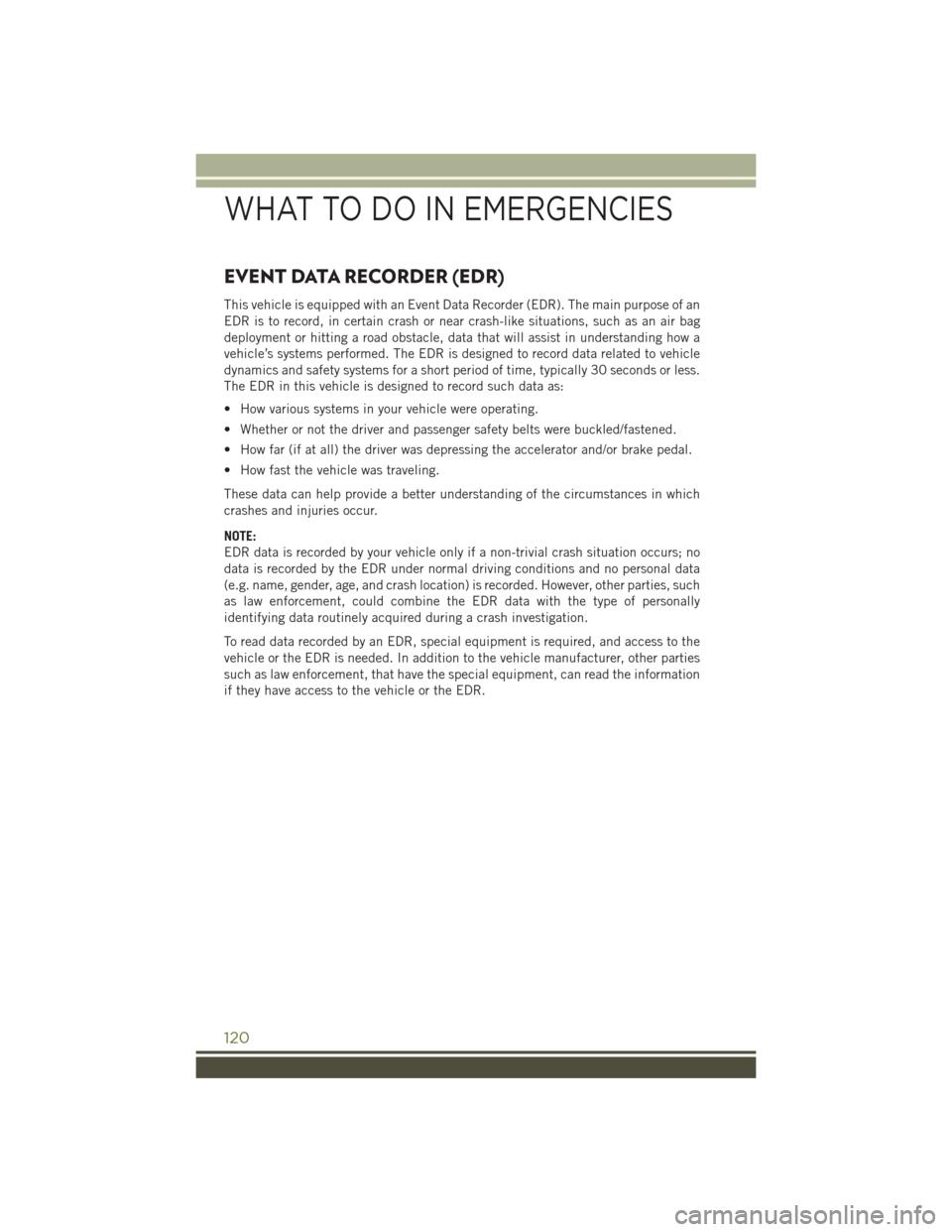
EVENT DATA RECORDER (EDR)
This vehicle is equipped with an Event Data Recorder (EDR). The main purpose of an
EDR is to record, in certain crash or near crash-like situations, such as an air bag
deployment or hitting a road obstacle, data that will assist in understanding how a
vehicle’s systems performed. The EDR is designed to record data related to vehicle
dynamics and safety systems for a short period of time, typically 30 seconds or less.
The EDR in this vehicle is designed to record such data as:
• How various systems in your vehicle were operating.
• Whether or not the driver and passenger safety belts were buckled/fastened.
• How far (if at all) the driver was depressing the accelerator and/or brake pedal.
• How fast the vehicle was traveling.
These data can help provide a better understanding of the circumstances in which
crashes and injuries occur.
NOTE:
EDR data is recorded by your vehicle only if a non-trivial crash situation occurs; no
data is recorded by the EDR under normal driving conditions and no personal data
(e.g. name, gender, age, and crash location) is recorded. However, other parties, such
as law enforcement, could combine the EDR data with the type of personally
identifying data routinely acquired during a crash investigation.
To read data recorded by an EDR, special equipment is required, and access to the
vehicle or the EDR is needed. In addition to the vehicle manufacturer, other parties
such as law enforcement, that have the special equipment, can read the information
if they have access to the vehicle or the EDR.
WHAT TO DO IN EMERGENCIES
120
Page 124 of 156
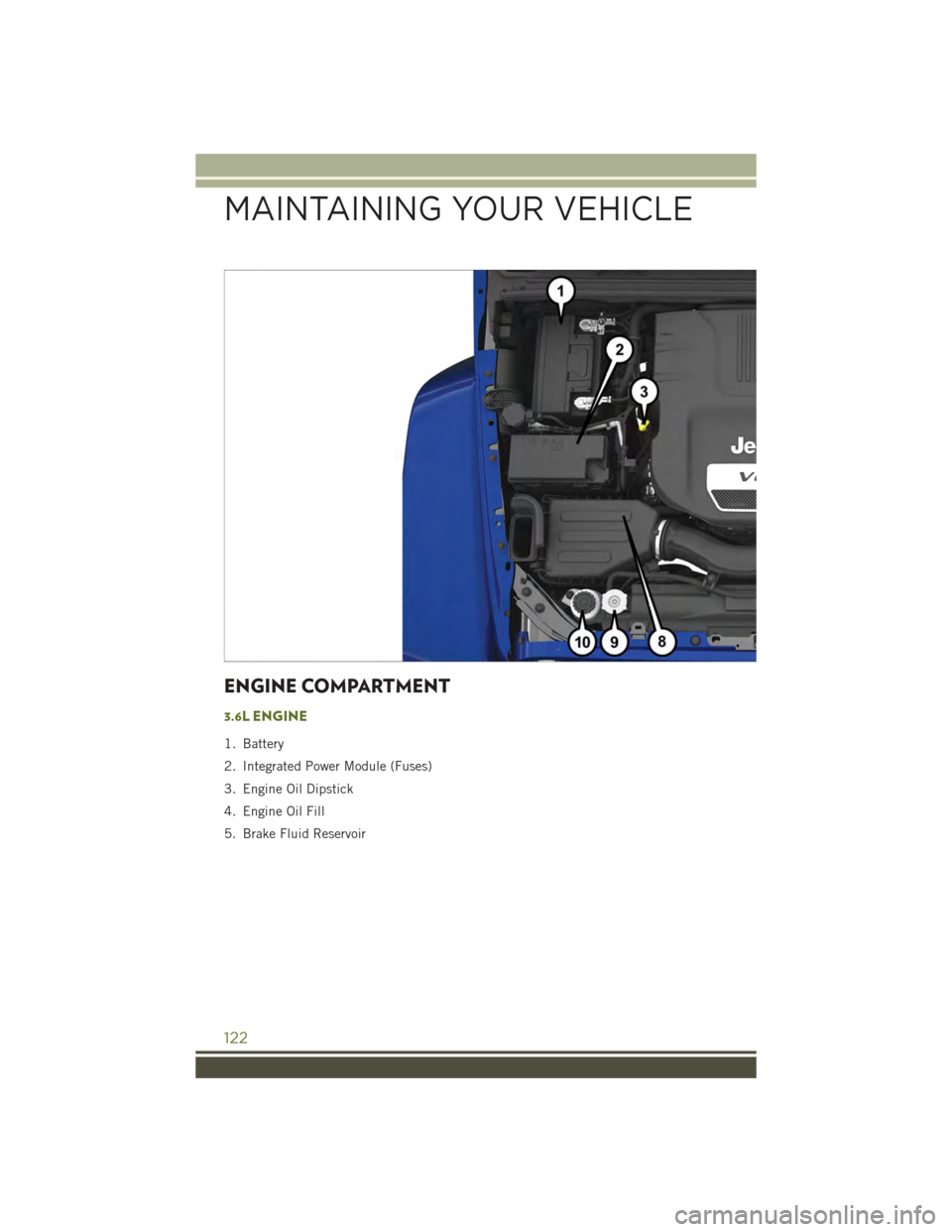
ENGINE COMPARTMENT
3.6L ENGINE
1. Battery
2. Integrated Power Module (Fuses)
3. Engine Oil Dipstick
4. Engine Oil Fill
5. Brake Fluid Reservoir
MAINTAINING YOUR VEHICLE
122
Page 127 of 156

CAUTION!
• Mixing of engine coolant (antifreeze) other than specified Organic Additive
Technology (OAT) engine coolant (antifreeze), may result in engine damage and
may decrease corrosion protection. Organic Additive Technology (OAT) engine
coolant is different and should not be mixed with Hybrid Organic Additive
Technology (HOAT) engine coolant (antifreeze) or any “globally compatible”
coolant (antifreeze). If a non-OAT engine coolant (antifreeze) is introduced into
the cooling system in an emergency, the cooling system will need to be drained,
flushed, and refilled with fresh OAT coolant (conforming to MS-12106), by an
authorized dealer as soon as possible.
• Do not use water alone or alcohol-based engine coolant (antifreeze) products.
Do not use additional rust inhibitors or antirust products, as they may not be
compatible with the radiator engine coolant and may plug the radiator.
• This vehicle has not been designed for use with propylene glycol-based engine
coolant (antifreeze). Use of propylene glycol-based engine coolant (antifreeze)
is not recommended.
Chassis
ComponentFluid, Lubricant, or Genuine Part
Automatic Transmission –If EquippedUse only ATF+4®Automatic Transmission Fluid. Failure touse ATF+4®fluid may affect the function or performance ofyour transmission. We recommend MOPAR®AT F + 4®fluid.
Manual Transmission –If EquippedWe recommend you use MOPAR®Manual Transmission Lubri-cant meeting the requirements of Chrysler Material StandardMS-9224.
Transfer CaseWe recommend you use MOPAR®AT F + 4®Automatic Trans-mission Fluid.
Axle Differential (Front) We recommend you use MOPAR®Gear & Axle Lubricant(SAE 80W-90) (API GL-5).
Axle Differential (Rear)226 RBI (Model 44)–We recommend you use MOPAR®Gear& Axle Lubricant (SAE 80W-90) (API GL-5) or equivalent. Fortrailer towing, use MOPAR®Synthetic Gear & Axle Lubricant(SAE 75W-140). Models equipped with Trac-Lok™ require anadditive.
Brake Master Cylinder We recommend you use MOPAR®DOT 3 Brake Fluid, SAEJ1703. If DOT 3, SAE J1703 brake fluid is not available,then DOT 4 is acceptable.
Power Steering Reservoir We recommend you use MOPAR®Power Steering Fluid +4,MOPAR®AT F + 4®Automatic Transmission Fluid.
MAINTAINING YOUR VEHICLE
125
Page 129 of 156
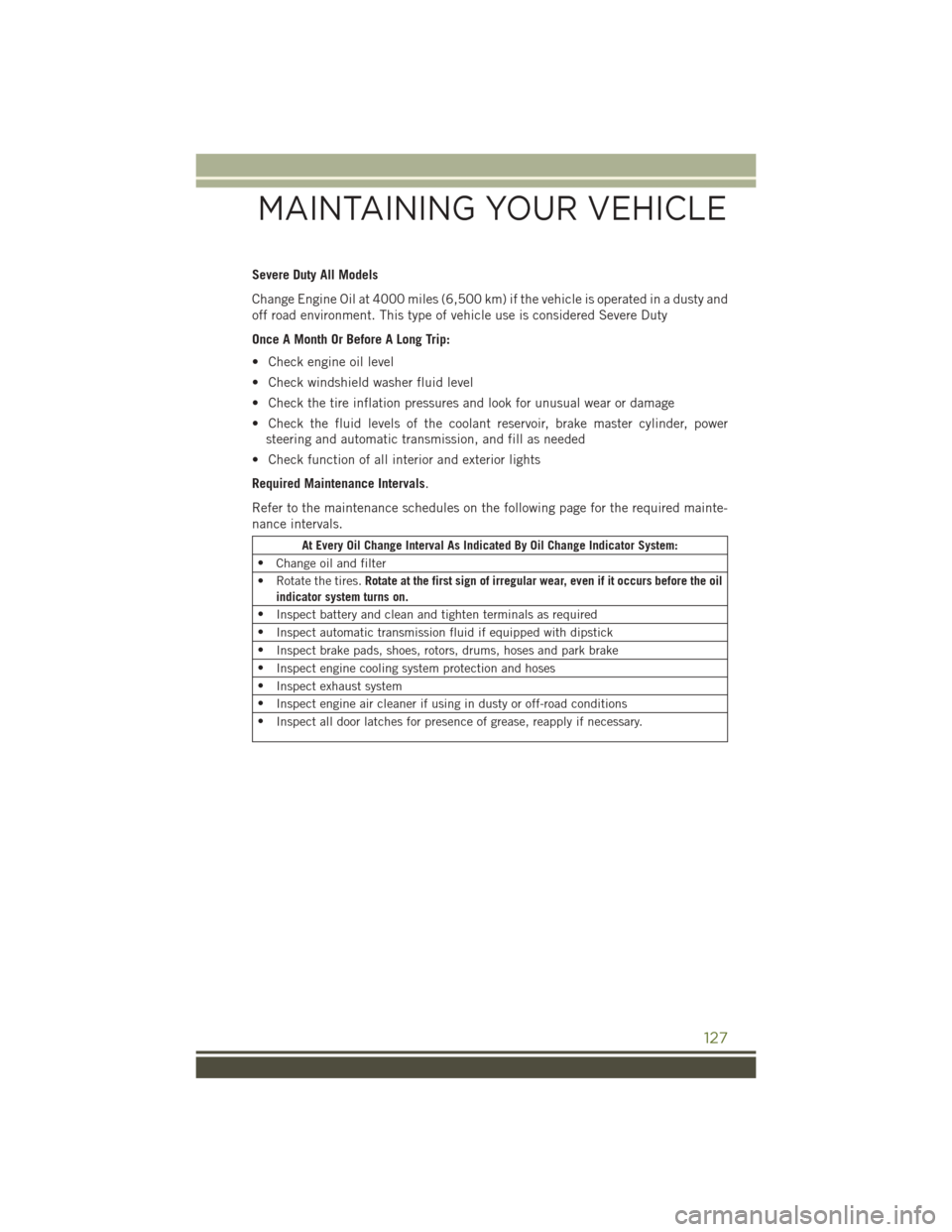
Severe Duty All Models
Change Engine Oil at 4000 miles (6,500 km) if the vehicle is operated in a dusty and
off road environment. This type of vehicle use is considered Severe Duty
Once A Month Or Before A Long Trip:
• Check engine oil level
• Check windshield washer fluid level
• Check the tire inflation pressures and look for unusual wear or damage
• Check the fluid levels of the coolant reservoir, brake master cylinder, power
steering and automatic transmission, and fill as needed
• Check function of all interior and exterior lights
Required Maintenance Intervals.
Refer to the maintenance schedules on the following page for the required mainte-
nance intervals.
At Every Oil Change Interval As Indicated By Oil Change Indicator System:
•Change oil and filter
• Rotate the tires.Rotate at the first sign of irregular wear, even if it occurs before the oil
indicator system turns on.
•Inspect battery and clean and tighten terminals as required
•Inspect automatic transmission fluid if equipped with dipstick
•Inspect brake pads, shoes, rotors, drums, hoses and park brake
•Inspect engine cooling system protection and hoses
•Inspect exhaust system
•Inspect engine air cleaner if using in dusty or off-road conditions
•Inspect all door latches for presence of grease, reapply if necessary.
MAINTAINING YOUR VEHICLE
127
Page 130 of 156
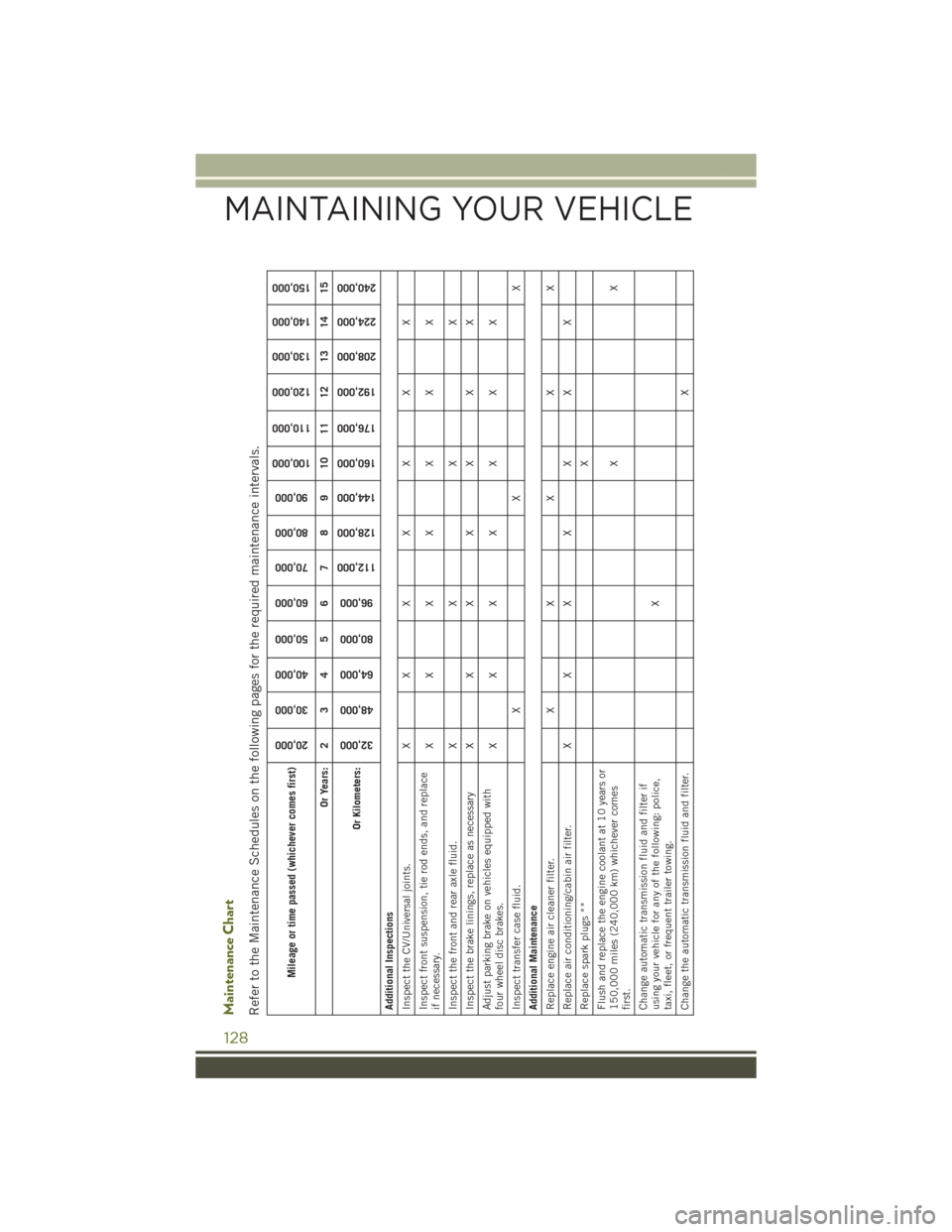
Maintenance ChartRefer to the Maintenance Schedules on the following pages for the required maintenance intervals.
Mileage or time passed (whichever comes first)
20,000
30,000
40,000
50,000
60,000
70,000
80,000
90,000
100,000
110,000
120,000
130,000
140,000
150,000
Or Years: 2 3 4 5 6 7 8 9 10 11 12 13 14 15
Or Kilometers:
32,000
48,000
64,000
80,000
96,000
112,000
128,000
144,000
160,000
176,000
192,000
208,000
224,000
240,000
Additional InspectionsInspect the CV/Universal joints. X X X X X X XInspect front suspension, tie rod ends, and replaceif necessary.
XX XXX XX
Inspect the front and rear axle fluid.
X
X
X
X
Inspect the brake linings, replace as necessary X
X
X
X
X
X
X
Adjust parking brake on vehicles equipped withfour wheel disc brakes.
XX XXX XX
Inspect transfer case fluid.
X
X
X
Additional MaintenanceReplace engine air cleaner filter.
X
X
X
X
X
Replace air conditioning/cabin air filter.
X
X
X
X
X
X
X
Replace spark plugs **
X
Flush and replace the engine coolant at 10 years or150,000 miles (240,000 km) whichever comesfirst.
XX
Change automatic transmission fluid and filter ifusing your vehicle for any of the following: police,taxi, fleet, or frequent trailer towing.
X
Change the automatic transmission fluid and filter.
X
MAINTAINING YOUR VEHICLE
128
Page 133 of 156
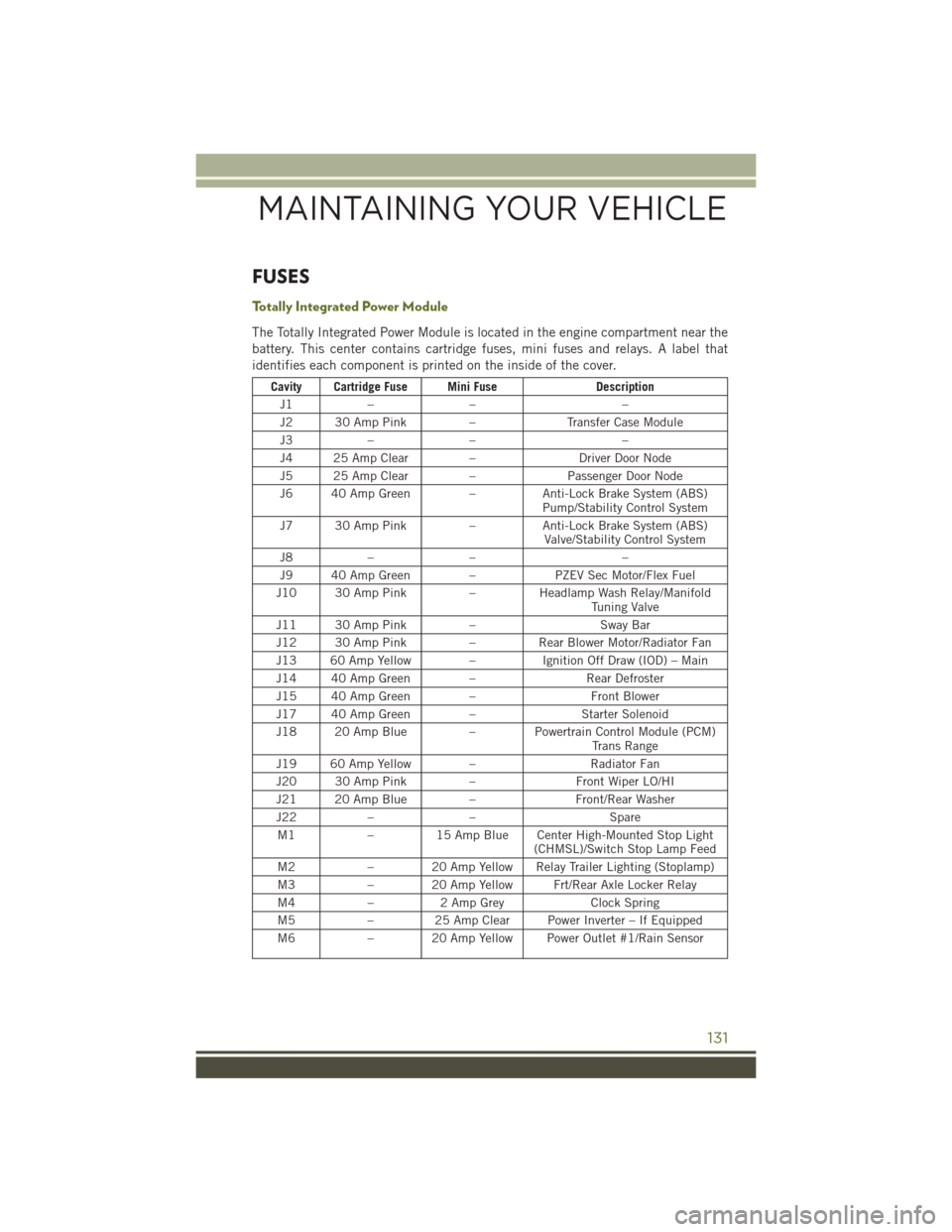
FUSES
To t a l l y I n t e g r a t e d P o w e r M o d u l e
The Totally Integrated Power Module is located in the engine compartment near the
battery. This center contains cartridge fuses, mini fuses and relays. A label that
identifies each component is printed on the inside of the cover.
Cavity Cartridge Fuse Mini FuseDescription
J1–––
J2 30 Amp Pink–Tr a n s f e r C a s e M o d u l e
J3–––
J4 25 Amp Clear –Driver Door Node
J5 25 Amp Clear –Passenger Door Node
J6 40 Amp Green –Anti-Lock Brake System (ABS)Pump/Stability Control System
J7 30 Amp Pink–Anti-Lock Brake System (ABS)Valve/Stability Control System
J8–––
J9 40 Amp Green –PZEV Sec Motor/Flex Fuel
J10 30 Amp Pink–Headlamp Wash Relay/ManifoldTu n i n g V a l v e
J11 30 Amp Pink–Sway Bar
J12 30 Amp Pink–Rear Blower Motor/Radiator Fan
J13 60 Amp Yellow –Ignition Off Draw (IOD) – Main
J14 40 Amp Green –Rear Defroster
J15 40 Amp Green –Front Blower
J17 40 Amp Green –Starter Solenoid
J18 20 Amp Blue– Powertrain Control Module (PCM)Trans Range
J19 60 Amp Yellow –Radiator Fan
J20 30 Amp Pink–Front Wiper LO/HI
J21 20 Amp Blue–Front/Rear Washer
J22––Spare
M1–15 Amp Blue Center High-Mounted Stop Light(CHMSL)/Switch Stop Lamp Feed
M2– 20 Amp Yellow Relay Trailer Lighting (Stoplamp)
M3– 20 Amp Yellow Frt/Rear Axle Locker Relay
M4–2AmpGreyClock Spring
M5–25AmpClearPowerInverter–IfEquipped
M6– 20 Amp Yellow Power Outlet #1/Rain Sensor
MAINTAINING YOUR VEHICLE
131
Page 135 of 156
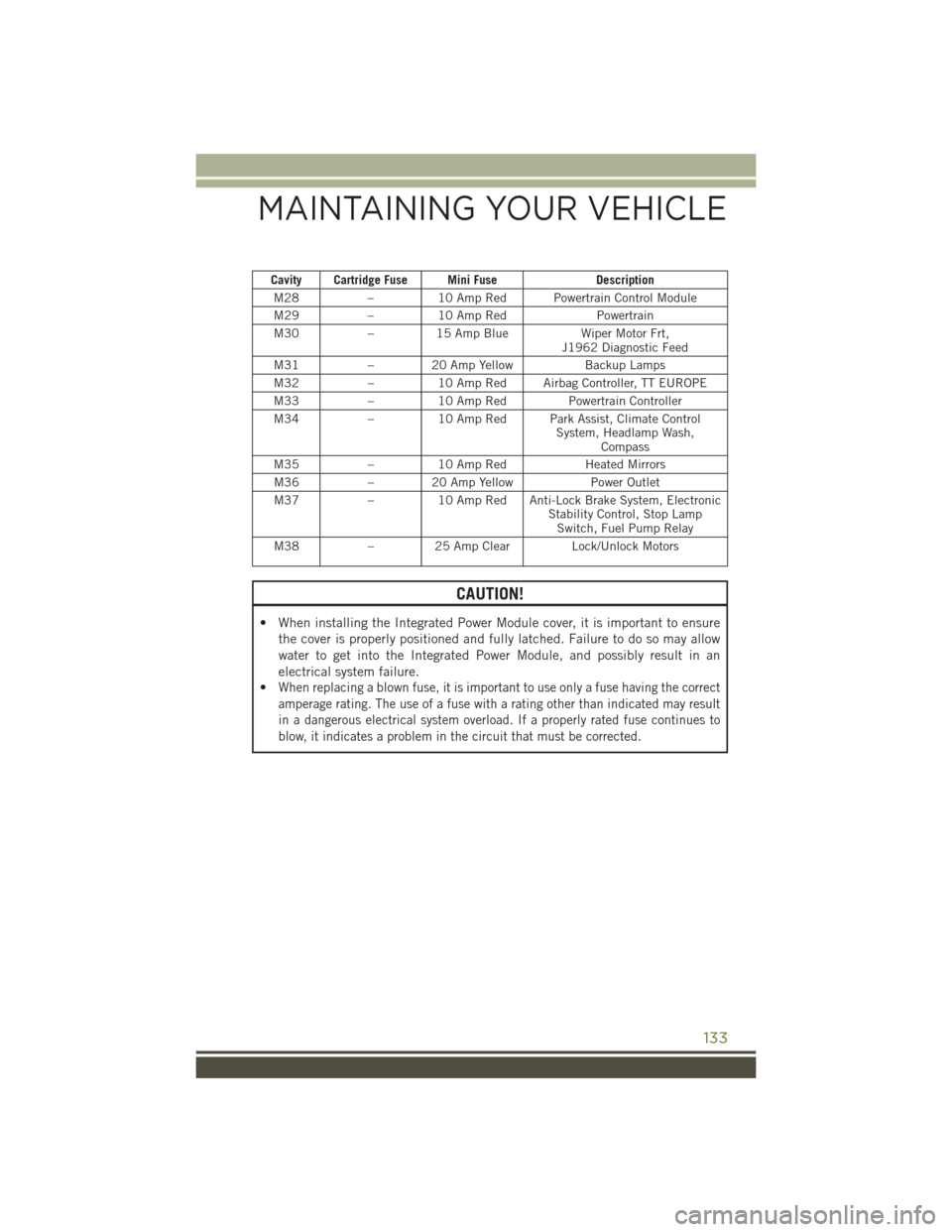
Cavity Cartridge Fuse Mini FuseDescription
M28–10 Amp Red Powertrain Control Module
M29–10 Amp RedPowertrain
M30–15 Amp BlueWiper Motor Frt,J1962 Diagnostic Feed
M31–20AmpYellowBackup Lamps
M32–10 Amp Red Airbag Controller, TT EUROPE
M33–10 Amp Red Powertrain Controller
M34–10 Amp Red Park Assist, Climate ControlSystem, Headlamp Wash,Compass
M35–10 Amp RedHeated Mirrors
M36– 20 Amp YellowPower Outlet
M37–10 Amp Red Anti-Lock Brake System, ElectronicStability Control, Stop LampSwitch, Fuel Pump Relay
M38– 25 Amp Clear Lock/Unlock Motors
CAUTION!
• When installing the Integrated Power Module cover, it is important to ensure
the cover is properly positioned and fully latched. Failure to do so may allow
water to get into the Integrated Power Module, and possibly result in an
electrical system failure.
•When replacing a blown fuse, it is important to use only a fuse having the correct
amperage rating. The use of a fuse with a rating other than indicated may result
in a dangerous electrical system overload. If a properly rated fuse continues to
blow, it indicates a problem in the circuit that must be corrected.
MAINTAINING YOUR VEHICLE
133
Page 139 of 156
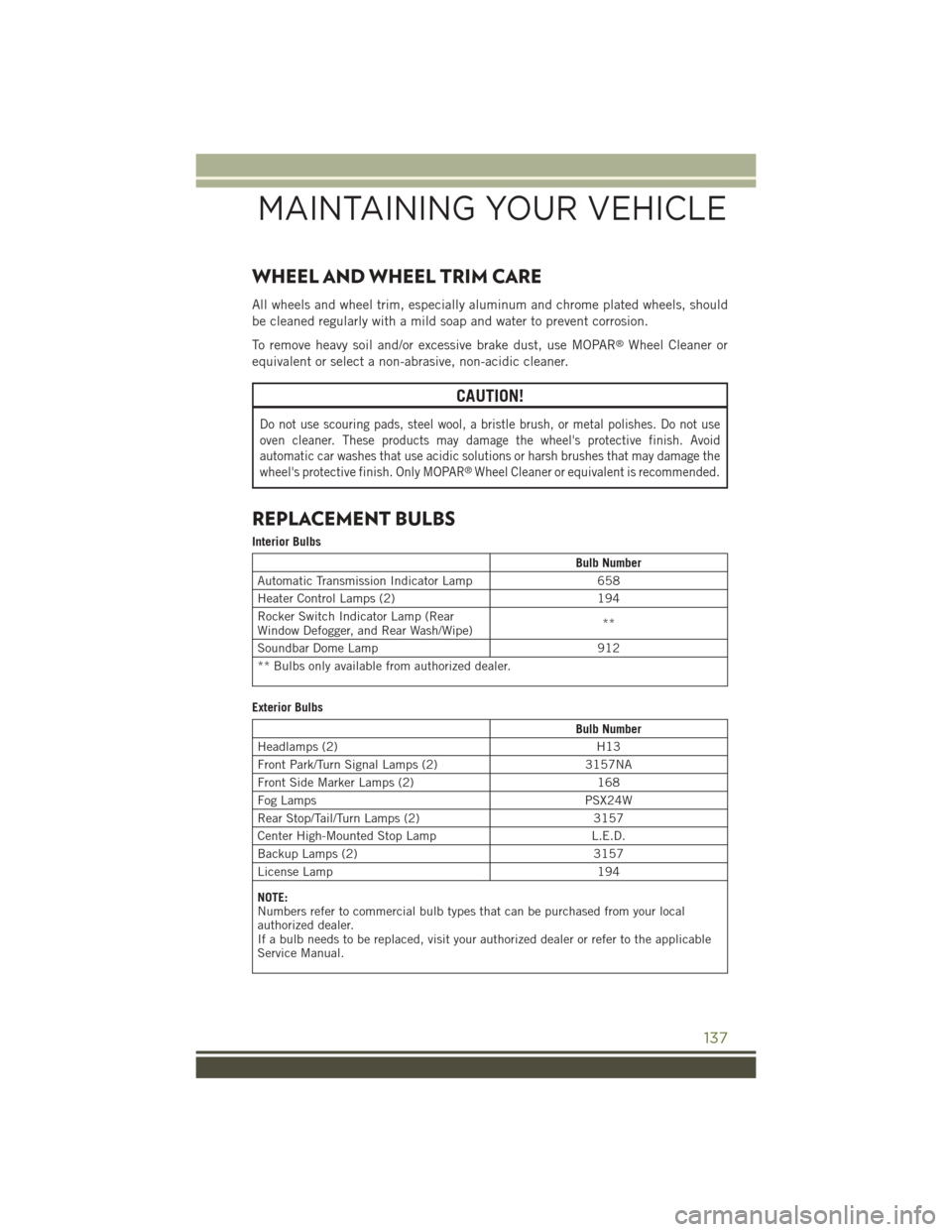
WHEEL AND WHEEL TRIM CARE
All wheels and wheel trim, especially aluminum and chrome plated wheels, should
be cleaned regularly with a mild soap and water to prevent corrosion.
To remove heavy soil and/or excessive brake dust, use MOPAR®Wheel Cleaner or
equivalent or select a non-abrasive, non-acidic cleaner.
CAUTION!
Do not use scouring pads, steel wool, a bristle brush, or metal polishes. Do not use
oven cleaner. These products may damage the wheel's protective finish. Avoid
automatic car washes that use acidic solutions or harsh brushes that may damage the
wheel's protective finish. Only MOPAR®Wheel Cleaner or equivalent is recommended.
REPLACEMENT BULBS
Interior Bulbs
Bulb Number
Automatic Transmission Indicator Lamp658
Heater Control Lamps (2)194
Rocker Switch Indicator Lamp (RearWindow Defogger, and Rear Wash/Wipe)**
Soundbar Dome Lamp912
** Bulbs only available from authorized dealer.
Exterior Bulbs
Bulb Number
Headlamps (2)H13
Front Park/Turn Signal Lamps (2)3157NA
Front Side Marker Lamps (2)168
Fog LampsPSX24W
Rear Stop/Tail/Turn Lamps (2)3157
Center High-Mounted Stop LampL.E.D.
Backup Lamps (2)3157
License Lamp194
NOTE:Numbers refer to commercial bulb types that can be purchased from your localauthorized dealer.If a bulb needs to be replaced, visit your authorized dealer or refer to the applicableService Manual.
MAINTAINING YOUR VEHICLE
137